The modern town of Aigeira is located on the northern coast of the Peloponnese, exactly equidistant from the the two main cities of the northern Peloponnesian coast–Patras (to the west) and Corinth (to the east). The modern town takes its name from an ancient one, the ruins of which are mainly found on a hill about 2.5 km to the southeast. It is directly across the Gulf of Corinth from Delphi, about 40 km away.
The 2nd-century-CE traveler Pausanias tells us that the name of the town was changed from Hyperesia (mentioned in Homer’s so-called “Catalogue of the Ships” in the Iliad) to Aigeira (based on the ancient Greek word aiges [“goat”]) as a result of an incident in which the city’s populace tied torches to the horns of a large herd of their goats at night in order to fool an overwhelming invading army from nearby Sikyon into thinking a large allied force had come to their aid. The ruse was successful, and the goats saved the day as the Sikyonians decided to head back home.
The main attraction of ancient Aigeira today is the theater, which was originally built in the 3rd century BCE but rebuilt in Roman times. The audience attending performances there would have had a spectacular view from up high over the Gulf of Corinth.
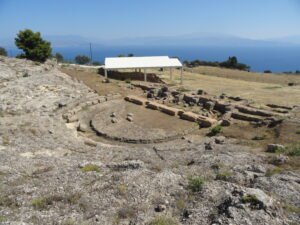
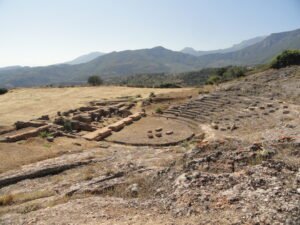
Next to the theater are two shrines protected by a modern roof which date to roughly the same time as the original theater.

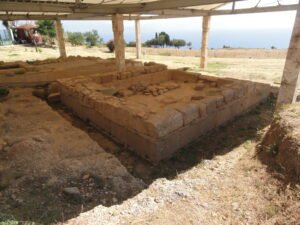
A third shrine which might be slightly younger was positioned on the other side of the stage.
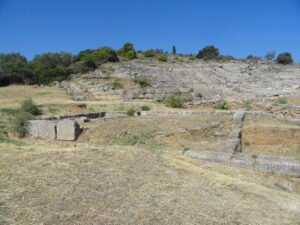
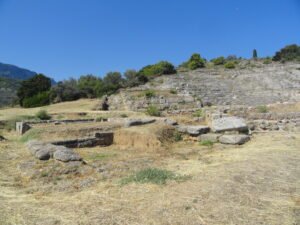
The oldest ruins were found higher up on the acropolis. There is evidence of habitation here as early as the 3rd millennium BCE, but some of the most interesting finds were made here in the late Mycenaean layers of the site. There were traces found there of a style of pottery found at some other late Mycenaen sites which is unlike that of standard Mycenaen pottery, and this has been seen by some as evidence of invaders–possibly a piece of the puzzle in solving the age-old mystery of why Mycenaean (and other Bronze Age societies in the eastern Mediterranean) suddenly collapsed around 1200 BCE.
There are some rockpiles and excavation pits up on the highest level of the acropolis.
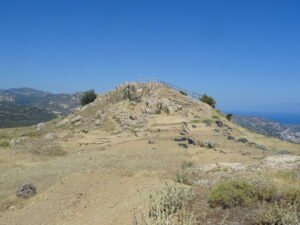
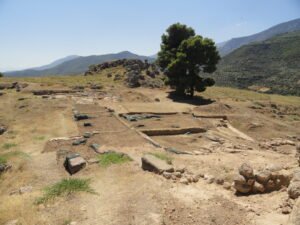
Looking down to the northwest from there, you can see the stone foundations of excavated structures on a slightly lower ledge of the acropolis.
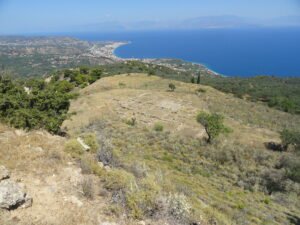

Pausanias mentioned that Aigeira was a port city, and indeed there are traces of an ancient harbor at the northern end of the village of Mavra Litharia. In more recent years, a large sanctuary was uncovered right at the edge of the modern town during the construction of a highway tunnel.
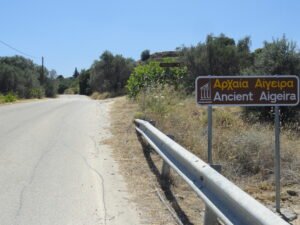 Tips for the Visitor
Tips for the Visitor
For those without their own transportation, the easiest way to get to ancient Aigeira is to use the non-express bus operated by KTEL Achaias which runs between Athens and Patras with stops at Aigio, Krathi, and Corinth. You’ll want to get off at Krathi, and the ride there will take around an hour from Patras or just under two hours from Athens. There’s a small taxi rank across the street from the bus company’s office in Krathi where the bus stops, and from there the 15-minute/8-km taxi ride up into the hills to the site will cost you around 12 euro. You can ask the driver for their phone number if they are open to coming back for you when you’re finished with the sights.
The theater is free of charge at the time of this writing, but it is gated and staffed, so be sure to check the opening times when planning your visit, although if you get unlucky and happen to find it closed, it is visible through the fence. The acropolis is not gated or staffed and can be visited at any time. The signposted path to get up to the acropolis breaks off the main road about half a kilometer before the entrance to the short path leading down to the theater, so after seeing the theater, you’ll need to hike a little over a kilometer–half of it uphill–to get up to the acropolis.
Location Map
